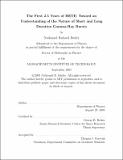The first 2.5 years of the HETE : toward an understanding of the nature of short and long duration gamma-ray bursts
Author(s)
Butler, Nathaniel Richard, 1976-
DownloadFull printable version (2.594Mb)
Alternative title
First 2.5 years of the High Energy Transient Explorer
Other Contributors
Massachusetts Institute of Technology. Dept. of Physics.
Advisor
George R. Ricker.
Terms of use
Metadata
Show full item recordAbstract
The HETE satellite became operational on the 2nd of February, 2001. In the first 2.5 years of the mission prior to July 1 of 2003, 42 Gamma-ray bursts (GRBs) were promptly localized and publicized over the GRB Coordinates Network (GCN). The first part of this thesis deals with the detection of GRBs in data down-linked from the HETE satellite using a suite of automated routines. This "ground triggering" was designed to supplement the HETE on-board triggering systems. To date, it has facilitated the broadcast of six HETE GRBs to the GCN. A novel trigger search routine using wavelets, which is included in the suite, is discussed. Near real time searches for very long duration (> 300s) GRBs using this and other methods are presented. The second part of the thesis focuses on imaging observations with Chandra of two GRB X-ray afterglows and high-resolution spectroscopic observations of five GRB X-ray afterglows. The imaging observations explore the nature of the class of short/hard GRBs and the class of "optically dark" GRBs, while the spectroscopic observations probe the relation of the long/soft class of GRBs to supernovae. Our observations suggest that no long/soft GRBs are optically dark. Rather, many appear to be "optically faint." In one case, a short/hard GRB may have been optically dark, because it lacked entirely an afterglow in the optical, radio, and X-ray bands. Finally, If the emission lines we detect in a Chandra spectrum of the X-ray afterglow to GRB 020813 are real, then a supernova likely occurred 2 2 months prior to the GRB. The statistical significance of the discrete spectral features reported to date in high resolution spectra taken with Chandra are discussed in detail, as the believability of the features is critical to moving forward in the field.
Description
Thesis (Ph. D.)--Massachusetts Institute of Technology, Dept. of Physics, 2003. Includes bibliographical references (p. 121-126). This electronic version was submitted by the student author. The certified thesis is available in the Institute Archives and Special Collections.
Date issued
2003Department
Massachusetts Institute of Technology. Department of PhysicsPublisher
Massachusetts Institute of Technology
Keywords
Physics.